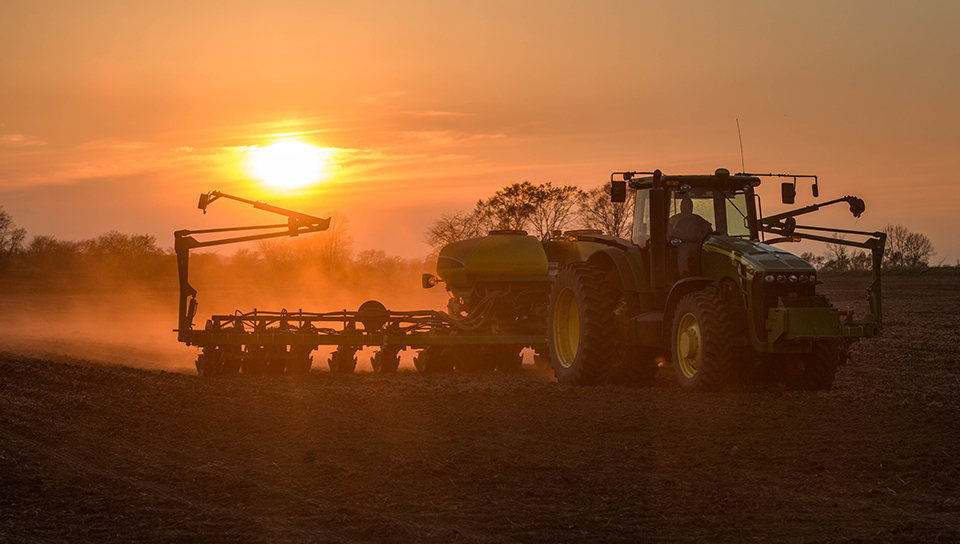
While 4 million acres have been reduced from the soybean planted area, corn gained 2 million. (Photo: Iowa Soybean Association).
Soybean prices rise after acreage numbers drop
July 6, 2023 | Kriss Nelson
The U.S. Department of Agriculture’s (USDA) National Agricultural Statistics Service June acreage report was a shock to many and the markets responded.
“This is always an important report, but we rarely see swings of this magnitude,” says Chad Hart, Iowa State University Extension economist. “We usually hope it is a smooth report, but it wasn’t.”
Following the announcement, which estimated soybean area planted to 83.5 million acres and corn estimated to 94.1 million acres planted in 2023, markets sent corn down more than 20 cents and beans up 80 cents.
“Trade was caught on both ends,” says Hart. “The acreage numbers for soybeans were below expectations and the acreage for corn was well above expectations and there was a significant adjustment in the marketplace to match.”
A surprise came from a 2 million-acre addition to corn acres and a 4 million-acre drop in the soybean area planted.
The addition of 2 million acres planted to corn and with USDA’s trend line yield at 181 bushels to the acre is adding nearly a 350 million bushel potential.
Although the drought monitor shows yields could be below trend, they did not consider conditions in this report.
“They’re taking what was already projected to be the largest corn crop, and they just made it larger,” says Hart. “When you are dealing with the potential there is a big crop, that sent the corn market substantially down.”
The drop of 4 million soybean acres was beyond industry expectations.
“The industry was expecting 87 to 88.5 million acres. We got 83.5. Everybody missed this one,” says Hart.
This big market readjustment translates to a 200 million bushel drop in expected production.
“You’re taking a market that was already tight, and you have made it much tighter,” he says.
The acreage shift
Where did those 4 million acres of soybeans go?
Besides corn gaining 2 million acres, hay gained more than 2 million acres; sorghum acreage was up 800,000; spring wheat up nearly 600,000 acres, and a variety of small grains make up the missing acres.
“Soybeans were the big loser in terms of area, but we saw a small drop in winter and durum wheat and cotton,” says Hart.
Grain Stocks
- Corn stocks totaled 4.11 billion bushels, down 6% from the same time last year. On-farm corn stocks were up 5% from a year ago, but off-farm stocks were down 15%.
- Soybeans stored totaled 796 million bushels, down 18% from June 1, 2022. On-farm soybean stocks were down 3% from a year ago, while off-farm stocks were down 26%.
- All wheat stored totaled 580 million bushels, down 17% from a year ago. On-farm all wheat stocks were up 34% from last year, while off-farm stocks were down 25%.
- Durum wheat stored totaled 28.0 million bushels, up 18% from June 1, 2022. On-farm stocks of durum wheat were up 38% from June 1, 2022. Off-farm stocks of durum wheat were up 6% from a year earlier.
“From the stock’s side, while much less dramatic, we had some bullish stories across the board,” says Hart.
Hart noted both corn and wheat stocks came below industry expectations and while soybean stocks were within range, they were also on the lower end.
Although there was some crop disappearance in the grain stocks report, the markets did not respond.
“The big story as far as why the markets did what they did is all wrapped up in the acres,” says Hart.
Soybean export market
With soybean stocks coming in on the lighter side, the focus is on the export market.
“The export markets were struggling on the soybean side before the price reaction from the acreage report,” says Hart. “This will not help that. Bringing soybean prices up, the U.S. may be in a tight spot for soybeans, but the world is not.”
WASDE report
The July USDA’s World Agricultural Supply and Demand Estimate (WASDE) report will be released on July 12.
Hart is curious what the report will say since the balance sheet situation once showed supplies were expected to be bigger than demand is no longer the issue.
“It is not a good 100 million bushels below demand,” he says. “How much will the USDA adjust those demand factors down to match the smaller crop?”
Back